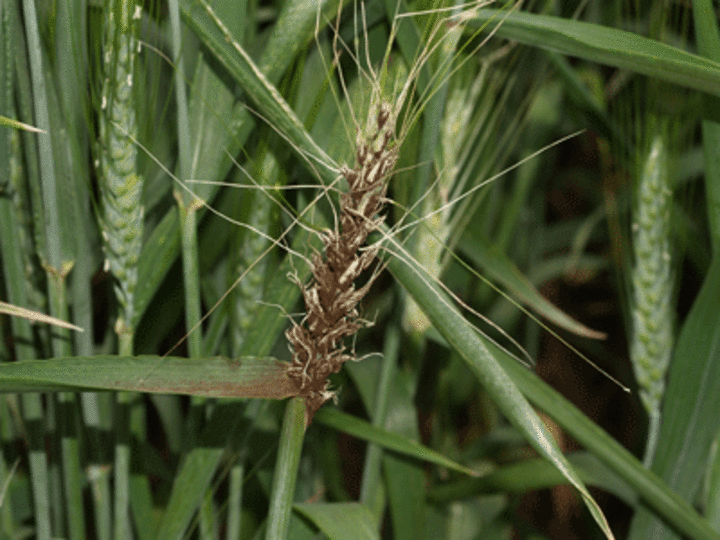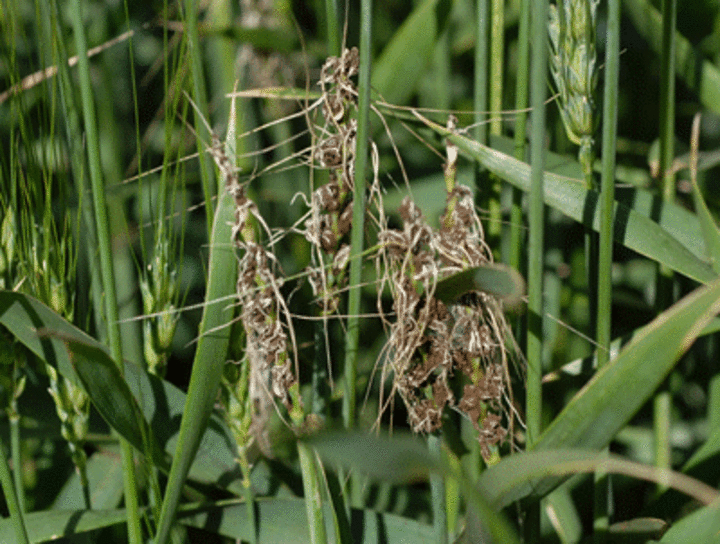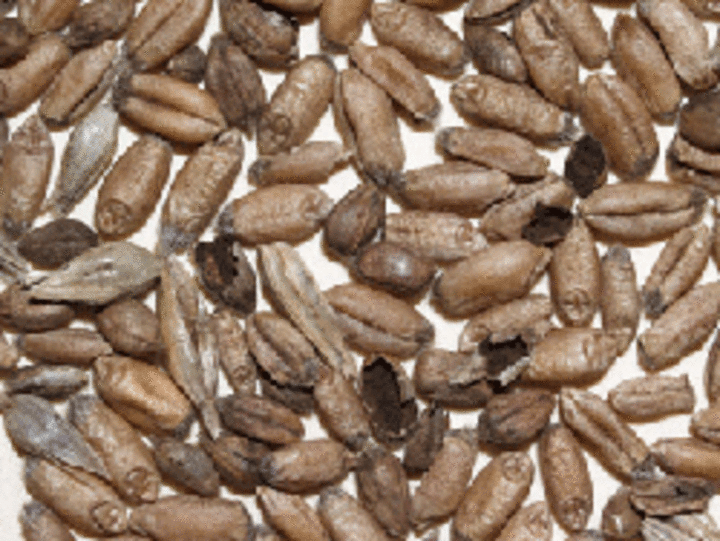
|

|
| Figure 1. Loose smut on a wheat head. | Figure 2. Loose smut in a field with a high incidence of the disease. Some parts of this field had up to 25% incidence of loose smut. |
May 29, 2009
Loose smut (Figure 1) is showing up in wheat fields. The disease is caused by the fungus Ustilago tritici which survives as dormant mycelium in the embryo of infected grain. Disease symptoms are not apparent until head emergence.
Smut Life Cycle
When infected grain is used as seed for the next crop, the mycelium grows following germination and systemically infects the plant and eventually colonizes and replaces the ovaries. Cells of the mycelium are converted to smut spores as the plant nears head emergence, resulting in the smutted heads that are currently showing up wheat fields.
Spores from the smutted heads are blown by wind and when they land on healthy flowering heads, they germinate, forming mycelium. The mycelium penetrates the ovary or stigma directly and colonizes the embryo of the developing seed or grain.
Potential Yield Loss
Percent yield loss due to loose smut is approximately equal to the percent of smutted heads in the field.
Management
It is too late to treat wheat for loose smut once smutted heads appear. To avoid loose smut in the next crop, grain from fields with loose smut should not be used as seed. A high percentage of grain infected by the loose smut fungus will lead to a high incidence of the disease the following growing season (Figure 2). If grain from fields with loose smut must be used as seed for the next crop, it should be treated with a seed treatment fungicide.
Seed Treatments

|
| Figure 3. Common bunt |
A partial list of seed treatment fungicides is provided in Table 1. Many of these fungicides also are effective against other seed transmitted smuts such as stinking smut, also known as common bunt (Figure 3).
Common bunt has a disease cycle similar to loose smut, except that infection by the common bunt fungus results from spores that contaminate the surface of the grain during harvest rather than seed-borne mycelium.
For a seed treatment fungicide to be effective, clean the grain before treatment and ensure thorough coverage of the grain with fungicide. It is recommended that grain be treated by a commercial seed treater. The most effective long-term solution to loose smut and common bunt is to always plant certified, fungicide-treated seed.
Stephen Wegulo
Extension Plant Pathologist
|
Table 1. |
||||
|
Trade Name
|
Active Ingredient(s) |
Rate |
Application |
Fungi/Diseases |
|
Allegiance -FL |
metalaxyl |
0.75 |
water-based slurry |
Pythium damping off |
|
Apron XL LS |
mefenoxam |
0.0425 – 0.085 |
slurry |
Pythium damping off |
|
Baytan 30 – For use only by commercial seed treaters |
Triadimenol |
0.75 – 1.5 |
slurry |
Smuts, foot rot, take-all, powdery mildew, leaf rust, stripe rust |
|
Captan |
captan |
1.5 – 4 |
slurry |
Seed and seedling rots, not bunt or smut |
|
Charter |
triticonazole |
3.1 |
slurry |
Smut, bunt, seedling blights, Fusarium crown and root rot, seed-borne Fusarium |
|
Cruiser Extreme |
thiamethoxam fludioxonilmefenoxamazoxystrobin |
See labels for Maxim XL, Apron XL, and Dynasty |
See labels for Maxim XL, Apron XL, and Dynasty |
Broad spectrum |
|
Dividend Extreme |
difenoconazole mefenoxam |
1 – 4 |
slurry |
Broad spectrum |
|
Dividend XL RTA |
difenoconazole mefenoxam |
2.5 – 10 |
slurry |
Broad spectrum |
|
Dynasty |
Azoxystrobin |
0.153 – 0.382 |
slurry |
Damping off, bunt |
|
Kodiak biological fungicide |
Bacillus subtilis |
0.05 – 0.1 oz |
slurry |
Rhizoctonia, Fusarium |
|
Maxim 4 FS |
fludioxonil |
0.08 – 0.16 |
slurry |
Fusarium, Rhizoctonia, Helminthosporium, Aspergillus, Penicillium |
|
Maxim XL |
fludioxonil mefenoxam |
0.167 – 0.334 |
slurry |
Fusarium, Rhizoctonia, Pythium, Aspergillus, Penicillium, bunt |
|
Raxil MD |
tebuconazole metalaxyl |
5 – 6.5 |
slurry |
Broad spectrum |
|
Raxil MD Extra |
tebuconazole metalaxylimazalil |
5 |
slurry |
Broad spectrum |
|
Raxil MD Extra W |
imidacloprid tebuconazolemetalaxylimazalil |
5.14 |
slurry |
Broad spectrum, includes the insecticide imidacloprid |
|
Raxil MD_W |
imidacloprid tebuconazolemetalaxyl
|
5 |
slurry |
Broad spectrum |
|
Raxil-Thiram |
tebuconazole thiram |
3.5 – 4.6 |
slurry |
Broad spectrum |
|
Raxil XT |
tebuconazole metalaxyl
|
0.5 lb pouch/40-50 hundredweights of seed; add 0.5 lb pouch of colorant |
slurry |
Broad spectrum |
|
42-S Thiram |
thiram |
2 |
slurry |
Broad spectrum |
|
RTU-Vitavax-Thiram |
carboxin |
5 – 6.8 |
Commercial seed treatment or pour-on hopper-box application |
Broad spectrum |
|
Fungicides listed represent the best information available. Reference to commercial products or trade names is made with the understanding that no discrimination is intended and no endorsement by the University of Nebraska-Lincoln Extension is implied. |
||||
